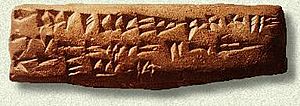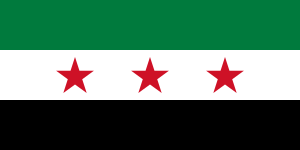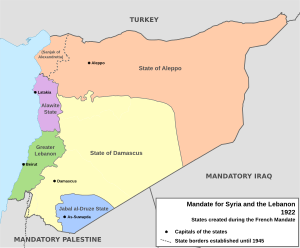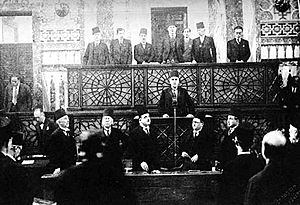History of Syria facts for kids
The history of Syria tells the story of events that happened in the land we now call the Syrian Arab Republic and the wider region of Syria. For a very long time, many powerful empires ruled this area. These included the Sumerians, Assyrians, Egyptians, Hittites, Romans, and many others. Syria became an independent country for the first time on October 24, 1945. This happened when the Syrian government signed the United Nations Charter, ending France's control over the region. France's rule officially ended in April 1946.
However, on February 21, 1958, Syria joined with Egypt to form the United Arab Republic. This union ended in 1961, and Syria became fully independent again. Since 1963, the Syrian Arab Republic has been led by the Ba’ath Party. The Assad family has been in charge of this party since 1970. Today, Syria is facing a difficult time due to the Syrian Civil War, with different groups fighting for control.
Ancient Times in Syria
Early Humans and Farming
The oldest signs of humans in Syria are from the Palaeolithic era, about 800,000 years ago. In 1993, a team found the bones of a Neanderthal child in Dederiyeh Cave. This child was about two years old and lived around 200,000 to 40,000 years ago. It was very special because it was an almost complete skeleton found in its original burial spot.
Archaeologists have found that civilization in Syria is very old. Syria is part of the Fertile Crescent, a region where farming and raising animals first began around 10,000 BCE. Early people used tools made from stone and traded with distant places like Anatolia. Important cities like Hamoukar and Emar grew during the later Stone Age and Bronze Age.
Early City-States and Empires
The ancient city of Ebla, found near Idlib in northern Syria in 1975, was a powerful city-state around 3000 BCE. At its strongest, from about 2500 to 2400 BCE, Ebla might have ruled a large area stretching from Anatolia to Damascus. Ebla traded with powerful states in Mesopotamia and even with Egypt. The language of Ebla is one of the oldest written languages we know.
Over thousands of years, many different empires and groups controlled parts of Syria. These included the Sumerians, Akkadians, Assyrians, Egyptians, Hittites, and Babylonians.


Ebla was likely taken over by the Akkadian Empire around 2330 BCE. It later became important again as part of the Amorites' lands, until the Hittites conquered it. The Mesopotamian people often called this region "the land of the Amurru" (Amorites).
Between the 22nd and 18th centuries BCE, parts of Syria were controlled by empires like the Neo-Sumerian Empire and the Old Assyrian Empire. Later, from the 15th to 13th centuries BCE, the Hittites, Egyptians, Assyrians, and Mitanni fought over the region. The Middle Assyrian Empire eventually gained control.
After the Middle Assyrian Empire weakened, new groups like the Canaanites, Phoenicians, and Arameans became important. From the 10th century BCE, the Neo-Assyrian Empire ruled Syria for about 300 years. The name Syria first appeared around this time, but it referred to the Assyrian Empire, which was a much larger area. After the Assyrian Empire fell, the Neo-Babylonian Empire ruled Syria for about 75 years.
Classical Era
Persian Rule in Syria
In 539 BCE, Cyrus the Great, the King of the Achaemenid Persians, added Syria to his empire. The Persians were very interested in Syria because of its location on the Mediterranean coast, its strong navy, and its many forests. They allowed the local Phoenicians to keep their own religions and businesses. Syrians were also allowed to build colonies across the Mediterranean. The Persian governors of Syria often lived in cities like Damascus or Sidon.
The Phoenicians helped the Persian kings in their military campaigns. For example, they provided their fleet to Xerxes I during his invasion of Greece. However, during the rule of Artaxerxes III, some Phoenician cities, including Sidon, rebelled against the Persians. These revolts were put down very harshly.
Greek Influence in Syria
Persian rule ended when Alexander the Great, the Greek king from Macedonia, conquered Syria in 333–332 BCE. After Alexander's death, his general Seleucus took control of Syria and created the Seleucid Empire. The capital of this empire was Antioch, which is now in Turkey but was part of historical Syria.
The Seleucid Empire and the Ptolemaic Kingdom of Egypt fought six wars, called the Syrian Wars, over a region known as Coele-Syria. These wars weakened both empires. By 100 BCE, the Seleucid Empire had shrunk to just Antioch and a few Syrian cities. In 83 BCE, after much fighting for the throne, Syrians chose Tigranes the Great, the King of Armenia, to rule their kingdom.
Roman Rule in Syria
The Roman general Pompey the Great captured Antioch in 64 BCE, making Syria a Roman province. Antioch became its capital. It was the third-largest city in the Roman Empire, after Rome and Alexandria. Antioch was a major center for trade and culture for many centuries. Syria was a very important Roman province, especially in the 2nd and 3rd centuries CE, because of its large and successful population. Cities like Palmyra and Emesa (modern-day Homs) became very wealthy and important.

Some Syrian nobles even became important figures in Rome. For example, Julia Domna, who came from Emesa, married Emperor Septimius Severus in 187 CE. Her family had a lot of influence. Another Roman Emperor of Syrian origin was Philip the Arab, who ruled from 244 to 249 CE. He was born in modern-day Shahba and worked to improve his hometown.
During the 3rd century, the Romans relied on Odaenathus, the King of Palmyra, to protect the eastern Roman lands from Persian invaders. Odaenathus was very successful in pushing back the Persians.

After Odaenathus died, his widow, Zenobia, led Palmyra in a rebellion against the Roman Empire. She conquered a huge area, including Syria, Asia Minor, and Egypt. However, her Palmyrene Empire did not last long. The Roman general Aurelian defeated Zenobia and sacked Palmyra around 273 CE, ending its power.

When the Roman Empire split, Syria became part of the Eastern Roman, or Byzantine, Empire in 395 CE. Syria was divided into smaller provinces. Christianity became the main religion of the empire, and Syria played a big role in its early history. Paul the Apostle became a Christian on the road to Damascus and was an important figure in the Church of Antioch.
Syria remained a very important region for the Byzantine Empire. It was briefly taken over by the Persians between 609 and 628 CE but was recovered by Emperor Heraclius. However, Byzantine rule in Syria ended when the Muslims conquered the region after the Battle of Yarmouk.
Medieval Era
Muslim Rule and Caliphates

Between 634 and 640 CE, Syria was conquered by Muslim Arabs led by Khalid ibn al-Walid. Syria then became part of the Islamic empire. In the mid-7th century, the Umayyad dynasty made Damascus the capital of their vast empire, which stretched from Spain to India. Syria became very rich and important as the center of this empire. Early Umayyad rulers built beautiful palaces and mosques in Damascus, Aleppo, and Homs.
During this time, Christians were generally treated well and some even held government jobs. In the mid-8th century, the Umayyad dynasty was overthrown by the Abbasid dynasty, who moved the capital to Baghdad. Arabic became the main language, replacing Greek and Aramaic. For some periods, Syria was ruled from Egypt by groups like the Tulunids and Ikhshidids. Northern Syria was controlled by the Hamdanids of Aleppo.
Crusaders, Mongols, and Mamluks

The court of Saif al-Daula (944–967) was a center for Arabic literature. He successfully defended Syria from Byzantine attempts to retake it. After his death, the Byzantines captured Antioch and Aleppo. Syria then became a battleground between different groups. The Byzantines eventually conquered all of Syria by 996 CE, but the fighting continued for much of the 11th century.
Syria was later conquered by the Seljuk Turks (1084–1086). Then, Nur ad-Din of the Zengid dynasty controlled the region between Aleppo and Damascus in 1154. Later, Saladin, who founded the Ayyubid dynasty in Egypt, conquered Syria (1175–1185).
During the 12th and 13th centuries, parts of Syria were held by Crusader states, like the Principality of Antioch. The area also faced threats from a group called the Assassins. In 1260, the Mongols briefly swept through Syria. However, when the main Mongol army left, the Mamluks from Egypt invaded and conquered Syria. The Mamluks made Damascus a provincial capital and successfully fought off several Mongol invasions.
In 1400, Timur Lenk, also known as Tamerlane, invaded Syria. He defeated the Mamluk army and captured Damascus. Many people in the city were killed, and skilled workers were sent to Samarkand. Christians in Syria also faced difficult times during this period.
By the end of the 15th century, new sea routes from Europe to the Far East meant that trade no longer needed to pass through Syria. In 1516, the Ottoman Empire conquered Syria.
Ottoman Era
Ottoman Sultan Selim I conquered most of Syria in 1516. Syria was part of the Ottoman Empire from 1516 to 1918. Ottoman rule was generally not too harsh on Syrians. The Turks, being Muslims, respected Arabic as the language of the Koran. Damascus became a major stop for pilgrims going to Mecca, which gave it a special holy status.
The Ottomans reorganized Syria into provinces. In 1549, Syria was divided into two main provinces: Damascus and Aleppo. Later, other provinces like Tripoli and Raqqa were created. The Ottoman government allowed different religious groups, like Shia Muslims, Greek Orthodox, and Jews, to manage their own community affairs.
During World War I, British and French diplomats secretly planned how to divide the Ottoman Empire after the war. This was called the Sykes-Picot Agreement of 1916. In October 1918, Arab and British troops entered Syria and captured Damascus and Aleppo. According to the agreement, Syria became a League of Nations mandate under French control in 1920.
In the early 20th century, there were big changes in the population of this area. Some Christian groups faced violence and were forced to leave their homes. Many Assyrians, for example, moved to northeastern Syria in the 1930s. Also, after 1926, many Kurds moved from Turkey to northeastern Syria and were given citizenship by the French.
Modern History
French Mandate in Syria
In 1919, a short-lived Arab Kingdom of Syria was set up under Emir Faisal I. In March 1920, the Syrian National Congress declared Faisal king of a larger Syria. However, his rule ended quickly after a fight between his Syrian forces and French troops. French troops took control of Syria and forced Faisal to leave. Later that year, the San Remo conference placed Syria and Lebanon under French control, and Palestine under British control. The French divided Syria into three separate regions.
People in Syria protested against French rule. A major revolt, led by Sultan al-Atrash, started in 1925 and spread across Syria and parts of Lebanon. There were fierce battles in Damascus, Homs, and Hama before the revolt was stopped in 1927. Sultan al-Atrash escaped and was later pardoned.
Syria and France tried to agree on a treaty of independence in 1936. France agreed to Syria's independence in principle, but wanted to keep its military and economic influence. Hashim al-Atassi became the first president elected under a new constitution. However, the French government never approved the treaty.
During World War II, Syria came under the control of Vichy France. Then, British and Free French forces occupied the country in July 1941. Syria declared its independence again in 1941, but it was not fully recognized until January 1, 1944. In 1945, there were protests because the French were slow to leave. The French responded with force, even shelling Damascus and killing many Syrians. Winston Churchill ordered British troops to intervene, and they made the French troops return to their barracks. Under pressure from Britain and Syrian groups, the French finally left in April 1946, and Syria became a fully independent republic.
Independence and Challenges
Syria became independent on April 17, 1946. The years after independence were very unstable. Between 1946 and 1956, Syria had 20 different governments and four new constitutions.
In 1948, Syria joined other Arab states in the 1948 Arab–Israeli War against Israel. The Syrian army entered northern Israel but was pushed back to the Golan Heights. A ceasefire was agreed in 1949. This war led to many Syrian Jews leaving the country due to increasing difficulties.
The war's outcome contributed to a series of military takeovers. In March 1949, Col. Husni al-Za'im led the first military coup in the Arab world since WWII. This was followed by other coups. Adib Shishakli took power in 1949 to prevent Syria from uniting with Iraq. He was overthrown in 1954. The Arab Socialist Ba'ath Party, founded in 1947, played a role in this.
In November 1956, Syria signed an agreement with the Soviet Union, which led to more Soviet influence and military equipment for Syria. This worried Turkey. The idea of uniting with Egypt became popular, especially after Egyptian President Gamal Abdal Nasser's leadership during the Suez Crisis. On February 1, 1958, Syria and Egypt merged to create the United Arab Republic. However, the union was not successful, and Syria left it in September 1961, becoming the Syrian Arab Republic again.
The 1960s saw many more coups and civil unrest. The coup on March 8, 1963, brought the Ba'ath Party to power. The new government was led by Michel Aflaq and Salah al-Din al-Bitar. In 1966, left-wing military leaders, led by General Salah Jadid, took over.
Under Jadid, Syria became closer to the Soviet Union and took a strong stance against Israel. At home, Jadid tried to quickly change Syrian society to a socialist system, which caused problems and economic difficulties. His government became less popular after Syria's defeat in the Six-Day War in 1967, when Israel destroyed much of Syria's air force and captured the Golan Heights.
On November 13, 1970, Minister of Defense Hafez al-Assad took power in a peaceful military takeover.
Syria under Hafez al-Assad (1970–2000)
After taking power, Hafez al-Assad quickly set up his government. He created a People's Council, a legislature where the Ba'ath Party held most seats. In March 1971, he was confirmed as president for a seven-year term. In 1972, he formed the National Progressive Front, a group of parties led by the Ba'ath Party. A new Syrian constitution was introduced in March 1973, defining Syria as a secular socialist state with Islam as the majority religion.
On October 6, 1973, Syria and Egypt launched a surprise attack on Israel, starting the Yom Kippur War. After heavy fighting, the Syrians were pushed back in the Golan Heights. Israel still occupies the Golan Heights today. In 1975, Assad said he would make peace with Israel if Israel withdrew from all occupied Arab land.
In 1976, the Syrian army entered the Lebanese civil war to help keep the peace. This began a thirty-year Syrian military presence in Lebanon. Many crimes in Lebanon were linked to Syrian forces, though not proven. In 1981, Israel officially claimed the Golan Heights. The next year, Israel invaded Lebanon and attacked the Syrian army. Syrian forces remained in Lebanon until 2005, having a strong influence on Lebanese politics. The assassination of former Lebanese Prime Minister Rafik Hariri in 2005 led to international pressure for Syria to withdraw its troops from Lebanon.

About one million Syrian workers went to Lebanon after the war to help rebuild the country.
The government faced challenges from fundamentalist Sunni Muslims in the late 1970s. These groups did not like the secular government and its rule by the Alawis. After the Islamic Revolution in Iran, Muslim groups started protests and riots. In response, Assad emphasized Syria's commitment to Islam. In February 1982, a major uprising by the Muslim Brotherhood in Hama was put down very harshly, with many people dying. Since then, open protests against the government have been rare. Assad also cracked down on other critics, jailing many important Syrian figures.
When Iraq invaded Kuwait in 1990, Syria joined the US-led group against Iraq. This helped improve relations with the US and other Arab countries. Syria also took part in peace talks with Israel in the 1990s, but these talks failed over the Golan Heights issue. There have been no direct Syrian-Israeli talks since 2000.
In 1994, Assad's son, Bassel al-Assad, who was expected to take over from his father, died in a car accident. When Hafez al-Assad died in 2000, his second son, Bashar al-Assad, became his successor.
Syria under Bashar al-Assad (2000–present)
Hafez al-Assad died on June 10, 2000, after 30 years as leader. Immediately, the Syrian Parliament changed the constitution to lower the minimum age for president from 40 to 34. This allowed Bashar al-Assad to be nominated by the Ba'ath party. On July 10, 2000, Bashar al-Assad was elected president without opposition, reportedly getting 97.29% of the votes.
The time after Bashar al-Assad's election was called the Damascus Spring. People hoped for reforms, and many political discussion groups formed in private homes. Activists called for democratic changes. Assad ordered the release of about 600 political prisoners in November 2000. However, by late 2001, the authorities stopped the reform movement, and arrests of leading thinkers continued.
Tensions with the USA grew after 2002. The US claimed Syria was getting weapons of mass destruction and supporting groups the US considered terrorists. In 2003, the US threatened sanctions. Syria denied these claims. An Israeli air strike near Damascus in October 2003 was called "military aggression" by Syria. In May 2004, the USA placed economic sanctions on Syria. Tensions increased further after the killing of former Lebanese PM Hariri in 2005, which the US linked to Syrian influence. Syria withdrew its forces from Lebanon by April 2005.
In October 2005, activists launched the Damascus Declaration, criticizing the Syrian government and calling for democratic reform. Leading critics were jailed. Although Bashar al-Assad spoke of reform, changes were mostly limited to the economy.
The authorities tightened Internet censorship, blocking websites like Wikipedia, YouTube, and Facebook for a time, though they were later unblocked.
Syria's international relations improved for a while. Diplomatic ties with Iraq were restored in 2006. In 2007, US House Speaker Nancy Pelosi met President Assad in Damascus, despite US President Bush's objections. An Israeli air strike in northern Syria in September 2007, which Israel claimed hit a nuclear facility, caused a setback. In 2008, Syria hosted an Arab League summit. Later that year, President Assad met French President Nicolas Sarkozy in Paris, signaling an end to Syria's diplomatic isolation.
In April 2008, President Assad said Syria and Israel had been discussing a peace treaty, with Turkey as a mediator. The status of the Golan Heights was a major topic. In 2008, an explosion killed 17 people near Damascus, which the government blamed on Islamist militants.
In 2009, US diplomats met with Syrian officials to discuss Middle East peace. Syria's stock exchange opened, a step towards a more open economy. In 2010, the USA sent its first ambassador to Syria after a five-year break. However, in May 2010, the USA renewed sanctions against Syria, saying it supported terrorist groups and sought weapons of mass destruction. In 2011, the UN's nuclear watchdog reported Syria to the UN Security Council over its alleged secret nuclear program.
Syrian Civil War (2011–present)

Controlled by Syrian Arab Republic Controlled by Autonomous Administration of North and East Syria, (Rojava) (SDF) Controlled jointly by Rojava (AANES) and Syrian Arab Republic Controlled by Syrian Interim Government (SNA) and Turkish Armed Forces Controlled by Revolutionary Commando Army and United States Armed Forces Controlled by the Islamic State (ISIL) Controlled by Syrian Salvation Government (HTS)
(For a more detailed, interactive map, see Template:Syrian Civil War detailed map.)

The Syrian Uprising, which became the Syrian Civil War, is an ongoing conflict between the Syrian army and many different rebel groups. Inspired by the Arab Spring, protests for reform began in Damascus and Deraa in March 2011. People demanded political freedom and the release of political prisoners. The government responded with force, deploying the Syrian Army.
Security forces shot and killed people in Deraa, leading to violent unrest that spread across the country. The government denied reports of soldiers refusing orders and blamed armed groups for the trouble. President Assad announced some changes, like releasing political prisoners and lifting the 48-year-old state of emergency. In May, army tanks entered several cities to stop protests. In June, the government claimed that 120 security forces members were killed by "armed gangs."
In July 2011, anti-Assad groups met in Istanbul and formed the Syrian National Council. Rebel fighters and army defectors formed the Free Syrian Army (FSA) and began fighting the government. The FSA was a collection of many independent groups.
In December 2011, Syria agreed to let Arab observers into the country, but the mission was suspended in January 2012 due to increasing violence. The UN Security Council supported a peace plan, but the violence continued. In May, the UN condemned both the government's use of heavy weapons and a massacre of civilians by rebels.
The UN reported that thousands of people had been killed in the first six months, including many civilians and children. Both sides have been accused of human rights abuses. The conflict has become a sectarian civil war, with leading government figures being Alawites and rebels mainly Sunni Muslims. Minorities like Christians and Druze have largely sided with the government, while others have joined the opposition or fought independently.
Many international groups have condemned the violence and applied sanctions against Syria. China and Russia have tried to prevent foreign intervention and called for talks. The Arab League and Organisation of Islamic Cooperation have suspended Syria's membership.
In October 2012, Syrian mortar fire hit a Turkish border town, killing civilians. Turkey returned fire and intercepted a Syrian plane. Both countries banned each other's planes from their airspace. In the south, Israeli forces fired on Syrian units after shelling from Syrian positions.
A UN-brokered ceasefire during the Islamic holiday of Eid al-Adha soon failed. By this time, millions of Syrians had been displaced within the country, and hundreds of thousands had fled to neighboring countries. According to one group, almost 44,000 people had died since the conflict began. A UN report stated that entire towns and neighborhoods had been destroyed and emptied of their populations.
In November 2012, the National Coalition for Syrian Revolutionary and Opposition Forces was formed. Many Western countries recognized this group as the main representative of the Syrian people. However, some Islamist rebel groups refused to join it. The US also added al-Nusra, a successful rebel group, to its terrorist list due to its ties to al-Qaeda.
In December 2012, a UN report said that Syria's newer rebel groups were increasingly acting on their own and some were linked to al-Qaeda. Many fighters were foreigners.
A sarin gas attack happened near Damascus on August 21, 2013. Some governments, like France and the United States, believed the Syrian government carried out the attack. This led to more international pressure and threats of military action against the Assad government.
On December 22, 2016, the city of Aleppo was fully captured by the Syrian Arab Army forces.
|
See also
 In Spanish: Historia de Siria para niños
In Spanish: Historia de Siria para niños
- Abila
- Adib Shishakli
- Bilad al-Sham
- Franco-Syrian Treaty of Independence (1936)
- Hashim al-Atassi
- History of the Levant
- History of Asia
- History of Damascus
- History of the Middle East
- List of presidents of Syria
- List of prime ministers of Syria
- Munir al-Ajlani
- Ottoman Syria
- Rulers of Damascus
- Politics of Syria
- Shukri al-Quwatli
- Syria
- Syrian Social Nationalist Party
- Taj al-Din al-Hasani
- Timeline of Syrian history
- Timeline of Damascus
- Usamah ibn Munqidh
- Kitab al-I'tibar Autobiography of Usamah













